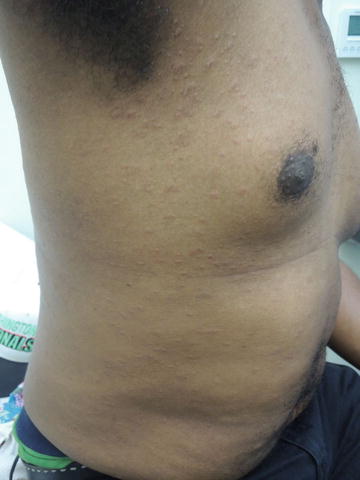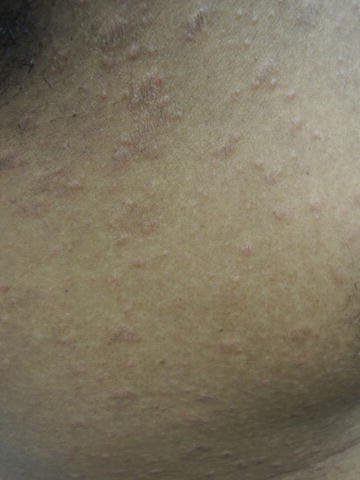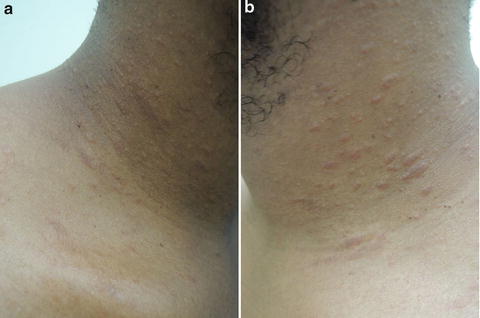, Corinna Eleni Psomadakis2 and Bobby Buka3
(1)
Department of Family Medicine, Mount Sinai School of Medicine Attending Mount Sinai Doctors/Beth Israel Medical Group-Williamsburg, Brooklyn, NY, USA
(2)
School of Medicine Imperial College London, London, UK
(3)
Department of Dermatology, Mount Sinai School of Medicine, New York, NY, USA
Keywords
Pityriasis roseaEruptionExanthemInfectionHuman herpesvirusHerpes virusHerpesHHV 6HHV 7AcuteHerald patchPregnancySpontaneous abortionMiscarriagePruritusAntihistamineAcyclovir
Fig. 25.1
Innumerable guttate papulo-plaques with fine scale predominate on the trunk

Fig. 25.2
Variably itchy, these lesions often follow a mild upper respiratory illness

Fig. 25.3
(a and b) Lesions also extend to the neck
Primary Care Visit Report
A 31-year-old male with past medical history of hypertension, treated with amlodipine, presented with an itchy rash over his torso and buttocks which started 5 days prior. The patient reported exacerbation with a hot shower, and improvement when he used moisturizing lotion.
Vitals were normal. On exam, scattered on his abdomen, torso, bilateral flanks and neck, there were many diffuse, slightly scaly, erythematous papules.
This was presumed to be pityriasis rosea and the patient was told it would resolve on its own.
Discussion from Dermatology Clinic
Differential Dx
Pityriasis rosea
Drug eruption
Tinea versicolor
Guttate psoriasis
Favored Dx
Definitive diagnosis would benefit from thorough history of the development of the rash. Pityriasis rosea often begins with a single, “herald patch ” although this is not present in all cases. Pityriasis rosea is the favored diagnosis in this case due to the eczematous papular appearance of lesions.
Overview
Pityriasis rosea is an acute, exanthematous (a skin rash occurring as a symptom of an infection or disease) eruption which is thought to be brought on by an infectious agent. Although bacteria, fungi, and viruses have all been implicated, the literature most strongly supports an association with reactivations of human herpesvirus (HHV) types 6 and 7 [1–3]. The exact etiology is unknown. The incidence in dermatology patients is estimated to be 0.68 %, and annual incidence is thought to be 0.16 % [1, 3]. Pityriasis rosea typically occurs in ages 10–35 years, and affects women more commonly than men [3]. A high proportion of women who develop pityriasis rosea during the first 20 weeks of gestation experience premature delivery, miscarriage , and spontaneous abortion [4].
Stay updated, free articles. Join our Telegram channel

Full access? Get Clinical Tree








